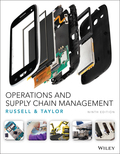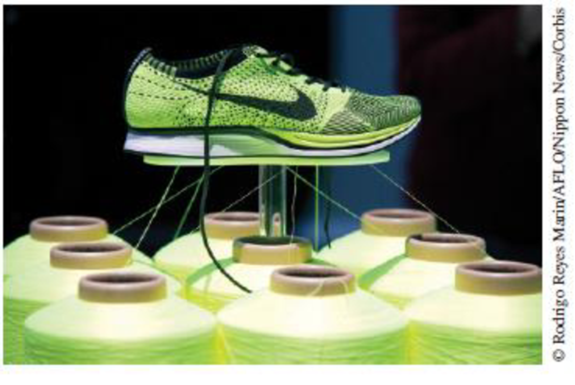
Consider Nike’s Flyknit Design
Nike has been aggressively pursuing sustainable design and production for more than a decade. Its Considered Design ethos asks designers to consider the environmental impact of a proposed product at the early stages of development; specifically, to use less toxins, less waste, more environmentally friendly materials, and more life cycle assessments (which promote recycling). To aid in that pursuit, Nike provides a list of environmentally preferred materials (EPM) and sustainable materials, as well as a restricted substances list (RSL) and restricted packaging list, to its suppliers and designers. A Considered Index is then calculated to evaluate the proposed design. Products or designs are scored on the use of solvents, waste, materials, treatments (such as fading or distressing), and innovation. Only those products that score significantly higher than the Nike average are designated as “Considered.”
The company has also developed a Sourcing & Manufacturing Sustainability Index (SMSI) that assesses contract factory performance on sustainability measures such as lean production, environmental performance (water, energy, carbon, waste), health and safety, and labor management factors. The company’s recycling program, called Reuse-A-Shoe, has recycled more than 21 million pairs of athletic shoes to create public basketball courts, athletic tracks, and playground surfaces around the world. Sustainability is now one of Nike’s core values, as noted in its recent annual report.
How appropriate, then, that one of Nike’s biggest commercial successes is also an environmental success—a 5.6 ounce running shoe called the Flyknit, which is shown in the photo. The Flyknit design changes the look, feel, performance, and manufacture of Nike’s biggest sales category, running shoes. The upper portion of these shoes are “knitted” on a custom-made 15-foot-long machine that weaves together colored polyester yarn and adds tiny synthetic cables into the weave around the midfoot for support. The cables loosen and contract with the runner’s foot, for form-fitting comfort and performance. For more stretch in the toe, Lycra-infused thread can be used; for added strength in the heel, multiple layers of yarn of varying thickness can be added. The warp and weft of the weaving process opens up interesting color combinations for the shoes as well. In the future, a shoe might be knitted to fit the particular needs of a customer’s feet (even if that means a different knit pattern for the left foot than the right).
The Flyknit has 35 fewer pieces to assemble than a traditional shoe and produces very little waste. Since there is no cutting, sewing, stitching, or gluing, the labor requirements and cost of manufacture are considerably less, too.

Nike has made great strides in apparel manufacturing, as well, with its ColorDry dyeing process. The new technology uses CO2 instead of water to dye material, eliminating wastewater pollution and avoiding depletion of a resource that is becoming increasingly scarce. Since it takes 30 liters of water to dye just one T-shirt and 5.8 trillion liters of water to dye apparel each year across the industry, using zero water makes a huge difference. The new process is 40% faster, too; it uses a quarter of the space and reduces energy consumption by 63%. Further, the color is more saturated, intense, and consistent.
Nike’s environmental actions promise to be a game-changer both for the company and the industry, and the resulting increase in profit is not bad either.
It’s not often that a design totally changes an industry. Can you think of other designs that have played that role? Comment on the competitive landscape for both the Flyknit and the example you find.
Want to see the full answer?
Check out a sample textbook solution
Chapter 4 Solutions
Operations and Supply Chain Management 9th edition
Additional Business Textbook Solutions
Principles of Operations Management: Sustainability and Supply Chain Management (10th Edition)
Intermediate Accounting (2nd Edition)
Essentials of Corporate Finance (Mcgraw-hill/Irwin Series in Finance, Insurance, and Real Estate)
Fundamentals of Management (10th Edition)
Horngren's Accounting (12th Edition)
Business Essentials (12th Edition) (What's New in Intro to Business)
- Question 6. An electrical engineering company is designing two types of solar panel systems: Standard Panels (S) and High-Efficiency Panels (H). The company has certain constraints regarding the hours of labor and material available for production each week. Each Standard Panel requires 4 hours of labor and 2 units of material and each High-Efficiency Panel requires 3 hours of labor and 5 units of material. The company has a maximum of 60 hours of labor and 40 units of material available per week. The profit from each Standard Panel is GH¢80, and the profit from each High-Efficiency Panel is GH¢100. The company wants to determine how many of each type of panel to produce in order to maximize profit. i) Solve this LPP by using graphical analysis ii) What will be the slack at the optimal solution point? Show calculation.arrow_forwardqusestion 6. An electrical engineering company is designing two types of solar panel systems: Standard Panels (S) and High-Efficiency Panels (H). The company has certain constraints regarding the hours of labor and material available for production each week. Each Standard Panel requires 4 hours of labor and 2 units of material and each High-Efficiency Panel requires 3 hours of labor and 5 units of material. The company has a maximum of 60 hours of labor and 40 units of material available per week. The profit from each Standard Panel is GH¢80, and the profit from each High-Efficiency Panel is GH¢100. The company wants to determine how many of each type of panel to produce in order to maximize profit. i. Formulate a linear programming model of the problem for the company. ii Convert the linear programming model formulated in (a) to a standard form.arrow_forwardG ווח >>> Mind Tap Cengage Learning 1- CENGAGE MINDTAP Chapter 09 Excel Activity: Exponential Smoothing Question 1 3.33/10 e Submit 自 A ng.cengage.com C Excel Online Student Work G A retail store records customer demand during each sales period. 1. What is the f... Q Search this course ? ✓ Co Excel Online Tutorial Excel Online Activity: Exponential Smoothing A-Z A retail store records customer demand during each sales period. The data has been collected in the Microsoft Excel Online file below. Use the Microsoft Excel Online file below to develop the single exponential smoothing forecast and answer the following questions. Office Video X Open spreadsheet Questions 1. What is the forecast for the 13th period based on the single exponential smoothing? Round your answer to two decimal places. 25.10 2. What is the MSE for the single exponential smoothing forecast? Round your answer to two decimal places. 21.88 Activity Frame ? 3. Choose the correct graph for the single exponential…arrow_forward
- Not use ai pleasearrow_forwardItems removed from the work area (5S) were taken to a storage area called ___________. Choose from: SORT, STORD, KNUJ, STUFF, FUDG SORT STORD KNUJ STUFF FUDGarrow_forwardCould you please help explain How was the poor strategic decisions lead to economic downturns of Circuit City Company? What are the sequences of key events and problems that contribute to its collapse. Could you please explain each one them and give the examples If Circuit City would apply Lean Six Sigma. would it helped prevent businesses from collapsed?? How Qualitative and quantitative Research Methodology in Case Study Research would affect Circuit City?arrow_forward
- Apple is a global technology company renowned for its innovation and design. To create its products, Apple has established a world class global supply chain to bring their products to market. What strategies is Apple using to source and manufacture its products? How does Apple view its responsibility to its suppliers and those who build its products?arrow_forwardCritical Path Method (CPM) is an important Project Management Tool that has wide industry application in modern day Project Management. By using an example of the project of your choice, critically examine the practical application of CPM as a Project Management Tool.arrow_forwardwhat is an other difination for principle?arrow_forward
- Need help or ideas to design out two slides as my script and writing quite long to squeese into two slides. But can just point form in slides with correct title and a good script for me to present two slides in only 2.5 mins. Following is my draft, pls guide me step by step on powerpoint creation and good script to present findings. My draft: Slide 1: Foreign Labor Exploitation in Dyson's Supply Chain Introduction Dyson's former Malaysian supplier, ATA IMS Bhd, became embroiled in serious labor exploitation allegations in 2021. These concerns surfaced when whistleblowers exposed unethical labor practices affecting migrant workers, primarily from Nepal and Bangladesh. Key Forms of Exploitation Debt Bondage Due to Recruitment Fees Workers were forced to pay exorbitant recruitment fees before securing employment, often taking loans at high interest rates. This financial burden trapped them in debt bondage, leaving them with little choice but to accept exploitative working…arrow_forwardNot use ai pleasearrow_forwardThe Business Development Bank of Canada. (2023). Canadian economic outlook for 2024: Shifting into neutral. https://www.bdc.ca/en/articles-tools/blog/canadian-economic-outlook-for-2024-shifting-into-neutral “Despite persistently high inflation and rising interest rates, the news was generally better than expected for the Canadian economy in 2023” (BDC Blog 2024). Discussion Question: In your view, what are the most pressing problems for Canadian companies or consumers in 2024? Explain your answer using current examples of companies or consumer concerns.arrow_forward
- MarketingMarketingISBN:9780357033791Author:Pride, William MPublisher:South Western Educational Publishing
 Purchasing and Supply Chain ManagementOperations ManagementISBN:9781285869681Author:Robert M. Monczka, Robert B. Handfield, Larry C. Giunipero, James L. PattersonPublisher:Cengage Learning
Purchasing and Supply Chain ManagementOperations ManagementISBN:9781285869681Author:Robert M. Monczka, Robert B. Handfield, Larry C. Giunipero, James L. PattersonPublisher:Cengage Learning Contemporary MarketingMarketingISBN:9780357033777Author:Louis E. Boone, David L. KurtzPublisher:Cengage Learning
Contemporary MarketingMarketingISBN:9780357033777Author:Louis E. Boone, David L. KurtzPublisher:Cengage Learning




